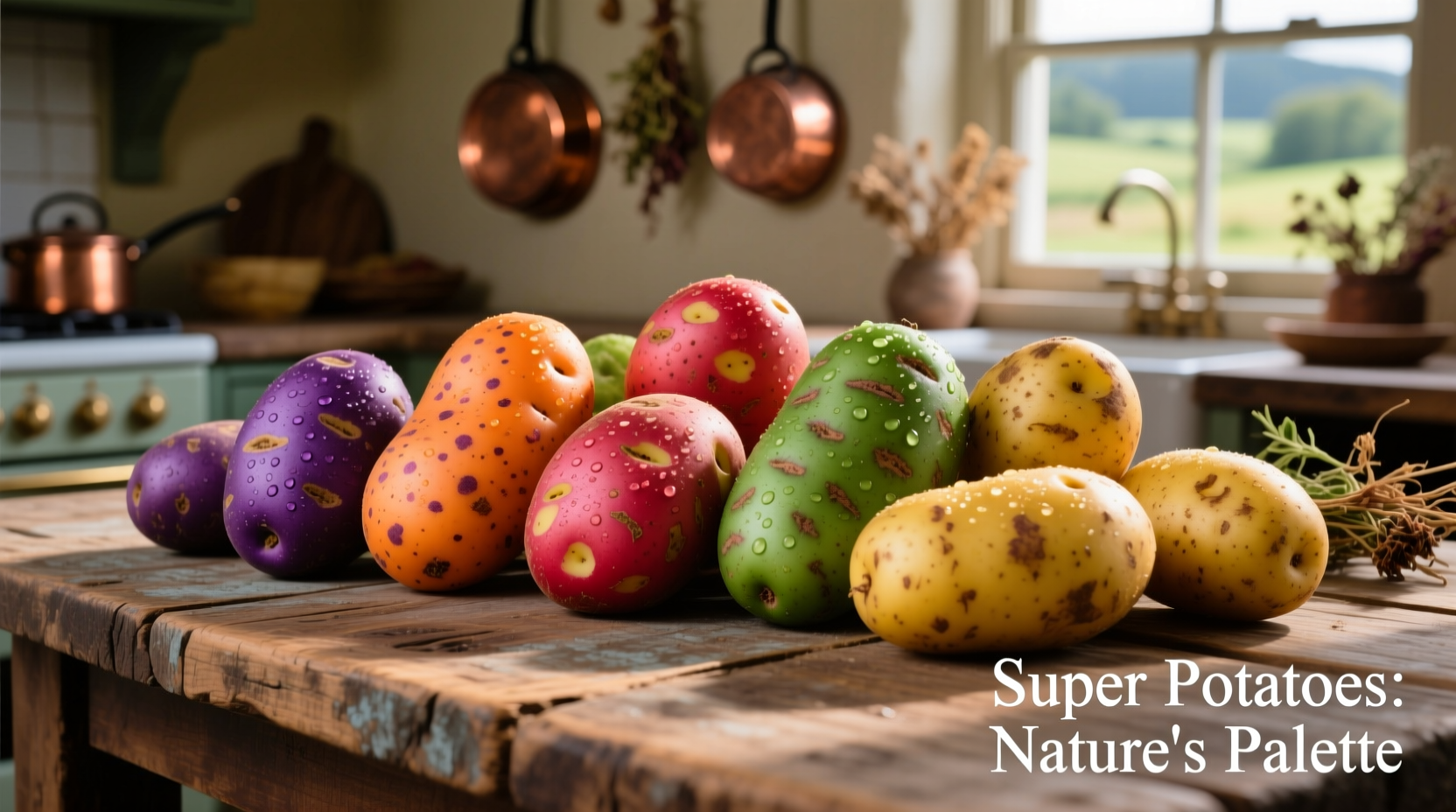What Exactly Makes a Potato "Super"?
When you search for "super potato," you're likely looking for more than just another spud. These aren't genetically modified creations but rather carefully bred or naturally occurring potato varieties that deliver exceptional nutritional value. Unlike standard white potatoes that primarily provide carbohydrates, super potatoes contain significantly higher concentrations of beneficial compounds that support overall health.
According to research from the USDA Agricultural Research Service, certain potato varieties contain anthocyanins (the same antioxidants found in blueberries) at levels comparable to many fruits traditionally considered "superfoods." These compounds give purple and red potatoes their distinctive color while providing powerful anti-inflammatory and cardiovascular benefits.
| Potato Variety | Antioxidant Content (μmol TE/100g) | Key Nutrients | Best Culinary Uses |
|---|---|---|---|
| Purple Peruvian | 1,800-2,200 | Anthocyanins, Vitamin C, Potassium | Salads, roasted, mashed (retains color) |
| Yukon Gold | 700-900 | Vitamin B6, Fiber, Iron | Mashed, roasted, soups |
| Sweet Potato | 1,200-1,500 | Vitamin A, Vitamin C, Manganese | Baked, roasted, pureed |
| Standard White | 400-600 | Potassium, Vitamin C | Boiled, fried, general purpose |
The data above comes from the USDA Agricultural Research Service, which has conducted extensive analysis of potato varieties across North America. This comparison clearly shows why certain potatoes earn the "super" designation through their superior nutritional composition.
How Super Potatoes Developed: A Brief Timeline
Potatoes have undergone significant development since their domestication in the Andes over 8,000 years ago. The evolution toward today's nutrient-enhanced varieties follows this progression:
- 8000 BCE: Initial domestication of wild potato species in modern-day Peru and Bolivia
- 1530s: Spanish explorers introduce potatoes to Europe, where selective breeding begins
- 19th century: Development of Russet Burbank, the standard white potato familiar today
- 1980s-1990s: Agricultural researchers begin intentionally breeding for color and nutritional content
- 2000s-present: Recognition of colored potatoes' health benefits leads to "super potato" marketing
This historical context explains why super potatoes aren't a recent fad but rather the result of centuries of agricultural development, with modern science helping us understand their nutritional advantages.

When Super Potatoes Shine (And When They Don't)
Understanding the context boundaries of super potatoes helps you make informed choices about when to incorporate them into your meals:
Situations Where Super Potatoes Excel
- Nutrient optimization: When you need maximum nutritional value from carbohydrate sources
- Colorful presentations: Purple potatoes maintain their vibrant hue when cooked properly
- Blood sugar management: Certain varieties have lower glycemic index values than standard potatoes
- Antioxidant boosting: When specifically targeting inflammation reduction through diet
Situations With Limitations
- Frying applications: Some colored varieties don't achieve the same crispness as Russets
- Long-term storage: Many super potato varieties don't store as well as traditional baking potatoes
- Cost considerations: Specialty varieties often cost 2-3x more than standard potatoes
- Availability: Limited seasonal availability outside major agricultural regions
Practical Ways to Incorporate Super Potatoes Into Your Diet
Knowing how to properly select, store, and prepare super potatoes makes all the difference in enjoying their benefits:
Shopping Guide for Super Potatoes
When selecting super potatoes, look for these quality indicators:
- Firm texture with smooth, unblemished skin
- Vibrant, consistent color (especially important for purple varieties)
- Medium size (8-10 ounces) for most cooking applications
- Store in cool, dark place (not the refrigerator) for optimal shelf life
Cooking Techniques That Preserve Nutrients
To maximize the nutritional benefits of super potatoes:
- Keep the skin on: Up to 50% of nutrients reside in or just beneath the skin
- Steam instead of boil: Reduces water-soluble nutrient loss by up to 30%
- Pair with healthy fats: Olive oil or avocado oil enhances absorption of fat-soluble nutrients
- Avoid overcooking: Preserves texture and nutrient content
Simple Super Potato Recipe Ideas
Try these straightforward preparations that highlight super potatoes' unique qualities:
- Roasted purple potato wedges: Toss with olive oil, rosemary, and sea salt; roast at 400°F for 25-30 minutes
- Yukon Gold potato salad: Boil with skin on, then mix with Greek yogurt, fresh dill, and diced celery
- Sweet potato breakfast bowls: Bake sweet potatoes and top with Greek yogurt, nuts, and berries
- Purple potato hummus: Blend cooked purple potatoes with chickpeas, tahini, and lemon juice
Where to Find Authentic Super Potatoes
Locating genuine super potato varieties requires knowing where to look:
Your best options include:
- Local farmers markets: Often carry specialty varieties not found in supermarkets
- CSA programs: Many community-supported agriculture programs feature heirloom and specialty potatoes
- Specialty grocery stores: Look for stores focusing on local or organic produce
- Growing your own: Several seed companies offer super potato varieties for home gardening
When shopping, be wary of misleading marketing. True super potatoes will specify their variety (like "Purple Peruvian" or "Vitelotte") rather than using generic "super potato" labels without botanical identification.











 浙公网安备
33010002000092号
浙公网安备
33010002000092号 浙B2-20120091-4
浙B2-20120091-4